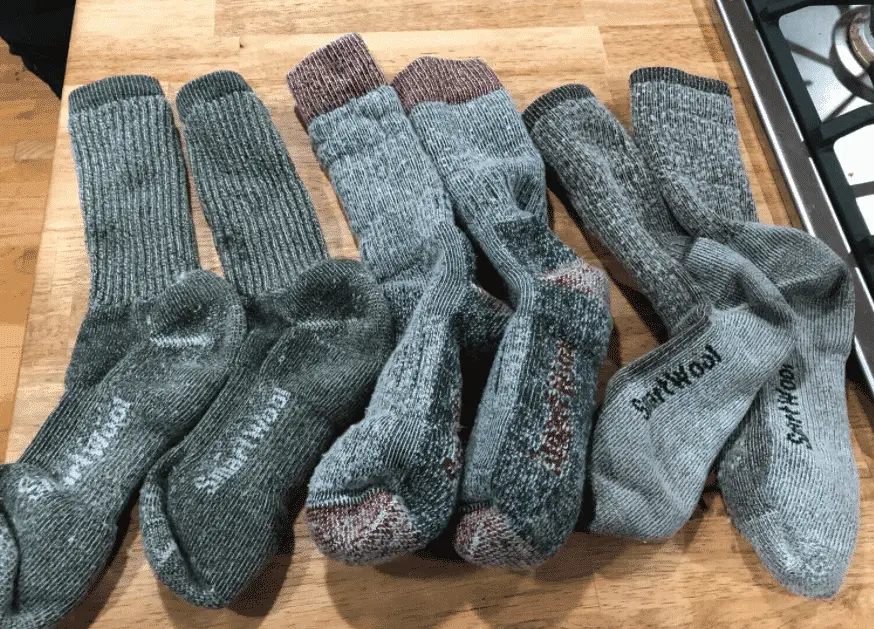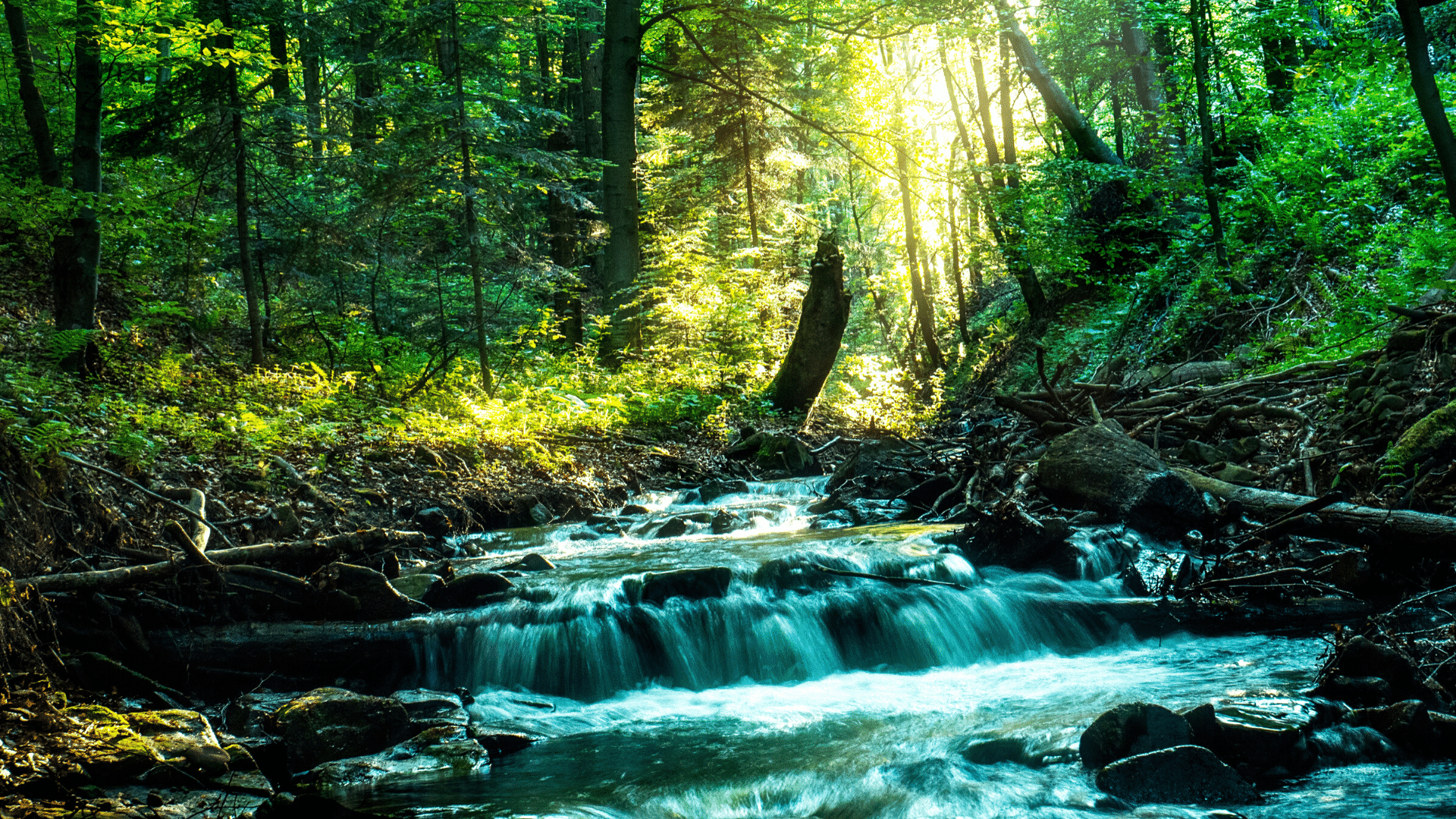Keeping your feet dry isn’t easy on a rainy hike. Throwing on a pair of waterproof hiking shoes isn’t the answer. You need to work on actively drying your feet throughout the day and proactively fighting against blisters. So how do you keep your feet dry in the rain?
You won’t be able to keep your feet dry while hiking in heavy rain. Water will get into your shoes and your socks will get wet. What you can do is manage the moisture with fast drying shoes, merino wool socks, and blister prevention techniques.
It’s more about managing moisture buildup than completely eliminating it. Find socks/shoes that are comfortable even when they’re wet and work on preventing blisters. Continue reading this article to learn how I manage wet feet when hiking in the rain.
Table Of Contents
How Do I Keep My Feet Dry While Hiking in The Rain?
Spring rain is coming down and there’s pooling water everywhere. This means there’s going to be a lot of stream crossings and muddy trails on local hikes. It’s a refreshing change from the snow, but you’ve got to deal with wet feet. Sometimes your just gonna get your friggin shoes wet!
After a long hike crossing streams, trudging through mud, your shoes and socks will get wet. There’s just no getting around wet feet during the rainy season.
When there’s been storms for days and no change in sight, there’s about 0% chance your feet will stay dry. Don’t Worry! Wet feet won’t kill you. You only need to worry about preventing trench foot on long wet backpacking trips.
There’s no way to keep your feet completely dry so you need to work on reducing harm to your feet. Focus on these three tasks.
- Quick-Drying Shoes: Don’t wear waterproof hiking boots. Water and sweat will get in and your boots won’t dry. You should wear lightweight mesh trail runners or running shoes. I really like Salomon Trail Runners.
- Merino Wool Socks: Merino wool socks are fast drying and they stay comfortable when wet. You don’t have to worry about blisters and the socks actually feels refreshing after getting wet. I really like Darn Tough and Smartwool Hiking Socks. Darn tough socks are more durable, but they’re seriously expensive.
- Blister Prevention: Apply Desitin or Footglide to your feet before putting on your merino wool socks. You shouldn’t have to worry about blisters.
- General Foot Care: Take lots of breaks and air out your feet whenever you get a chance. I like to carry 2-3 extra pairs of socks so I always have fresh socks once I get to camp.
Your Shoes Will Dry Just Go in The Water
Throughout our lives we’ve been brainwashed into thinking you need to keep your feet dry. We try to keep our clothes/shoes dry at work/school and that’s hard to let go.
It takes a lot of bravery to cast all that aside,and head out for a multi-day hike in nothing but mesh trail runners. Honestly, you’re better off with fast drying shoes and merino wool socks than waterproof hiking boots.
All this rain and flooding is confusing people. Nobody knows how to cross muddy paths and shallow creeks. Every year I see people turn back at the first sign of water. Fear of wet shoes and possibly going barefoot is apparently a powerful thing.
Last week I saw a man lose his big toenail. He didn’t want to get his shoes wet and tried to wade across a shallow silt-filled stream barefoot. He couldn’t see the bottom, tripped and smashed up his toe.
That same day I saw a man fall off a log trying to balance himself. He slipped off the log and dropped hard just so he could avoid getting his shoes wet.
These people look at me like I’m nuts walking through a stream with my shoes on. What is it about wet shoes that make us go insane? When people are willing to hurt themselves to avoid wet shoes there’s something wrong.
Under most circumstances you shouldn’t worry about getting your feet wet. Your feet will be fine, they are waterproof after all. Avoid water when it’s cold embrace it in the heat. A little bit of water isn’t going to kill you.
All Hikers Start off Fearing Wet Feet
Obviously, dry feet feel way better than wet feet, but wet feet are part of the game. To get the most out of hiking your feet will eventually get wet.
When I first started hiking/backpacking I thought I would get blisters if my shoes got wet. It took me several years to figure out that’s not the case. Pairing merino socks with meshy trail runners and your feet will dry in no time. People make way too big a deal about wet shoes.
I totally understand why so many people are afraid of blisters. Almost every hiker has had a blister at some point which intensifies the fear. Every new hiker has that perception that their trip will be ruined at the first sign of blisters.
Don’t Overcomplicate Things
I truly believe that the key to backpacking and hiking is to not overthink things. You don’t have to rely on fancy gear and overly complicated solutions to a simple problem. It’s not a big deal we’re just talking about a little water.
Dry Your Feet at Night

If you’re able to get your feet dry at night, which shouldn’t be all that difficult, you shouldn’t have any trouble. Having them wet during the day shouldn’t be much of an issue. That being said if I know my feet will likely get wet I apply a liberal coating of Hikegoo to prevent blisters.
Backpack long enough and you’ll eventually find a route that you just can’t get your feet dry. There’s no keeping your feet dry when you have streams/mud to cross. Just take your socks off when you get to camp, dry off your feet, hang the dirty socks and put on a fresh pair of wool socks(these are my favorite wool socks). In the morning put on some more anti-blister cream and get on with your day.
How to Dry Your Feet in Camp
Just let your feet get wet during the day and dry them out at night. I try to keep a few pairs of dry socks just to use around camp. When it’s really wet out you might want to bring an extra pair of dry camp shoes/crocs so you comfortably walk around at camp(high sidewall crocs are lightweight and comfortable).
When dealing with wet feet Gold Bond Powder will save your trip. Buy the small travel size bottle and apply it liberally once you get to camp. Only powder up your feet after hiking. Powder in wet shoes/socks is a recipe for a lumpy powder mess.
Wet Feet Can Lead to Blisters
Wet feet can quickly lead to blisters as you hike. As you’re hiking it’s important to stop for quick 5-10 minute breaks and air out your feet. Take your shoes off, get barefoot, dry out your feet and wring the water out of your socks. Reapply hikegoo or some other anti-blister cream.
When it comes to protecting your feet it all boils down to TLC. Never sleep with wet feet(if you can avoid it), remove/dry out your insoles at night, bring extra socks and air your feet out throughout the day. Take an extended lunch and air your feet out in the sun.
Gortex isn’t Always The Answer
Low cut Gortex boots are really nice for keeping your feet dry in wet morning grass or the occasional puddle. Hike all day in the rain and your feet will get wet and wet Gortex boots suck.
Gortex footwear is designed to be waterproof which is great, but when you inevitably get water inside they don’t want to dry. Gortex takes way longer to dry than traditional mesh shoes.
Here’s my non-scientific opinion: If gortex is great at keeping water out, it will also keep water in.
What About Gortex Socks in Camp?
If you don’t want to bring along an extra pair of camp shoes, you should pack goretex socks(these are great). Just dry off your feet and put them on. You can walk around camp in wet shoes and your feet will stay dry. Avoid overexerting yourself, because your feet will quickly overheat and sweat.
If you carry a dry camp shoe, use regular socks. When you only have your hiking footwear gortex socks are a great compromise. Just make sure you eventually give your feet a breather before heading to bed.
Waterproof Socks Won’t Protect You in Rain
Unless technology has significantly changed in the past couple years waterproof socks won’t actually protect you in the rain. Waterproof socks aren’t actually waterproof. They will keep your feet warm, but they won’t be dry.
What’s nice about waterproof socks is you won’t feel the cold puddles, but they take forever to dry(plus they smell real nasty). I might have burned a particularly nasty-smelling pair in a fire when I was younger.
Wear Merino Wool Socks

Merino wool socks are by far the best option in bad weather. If you’ve never tried Merino wool you’re missing out. The same pair of socks are ridiculously warm in the winter and cool in the summer.
Merino wool really starts to shine when it gets wet. They aren’t like traditional cotton or gortex socks. Merino wool does not rub and your feet stay warm when wet. Just buy a pair I guarantee you won’t regret it(these are my favorite merino wool socks)
Never Let Your Feet Get Wet in The Winter
Wet feet in the spring, summer, or fall is one thing, but winter is a whole different ball game. It’s really not the wet feet that causes most of the problem it’s the rest of your gear getting wet. You can warm/dry your feet at camp, but wet boots/socks will freeze overnight.
When hiking during the winter months prevention is key. You need to wear tall knee height gaitors, waterproof boots, warm wool socks, etc. Do anything you can to keep your feet dry.
Consider Wearing Sandals
If I know I’ll be dealing with several stream crossings, rainstorms, floods and swamps I might just wear sandals. I have found that open-toe sandals with a pair of cool max socks are extremely comfortable.
Merrell sandals are awesome(although they are expensive) and they hold up really well. When I’m really sweating there’s nothing better than wading in a shallow stream. My feet feel amazing for the 15 minutes it takes for my socks to dry. When your sandles/socks get dirty just rinse them off in a puddle.
With properly fitting sandals, you won’t have to deal with athlete’s foot, hammer toe or blisters. A nice little bonus is you’ll never have to put on wet sandals. A quality pair of hiking sandals will dry in under an hour.



